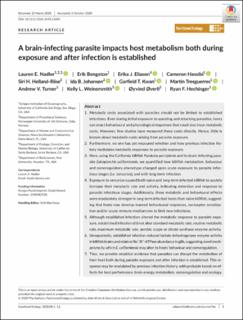| dc.description.abstract | 1. Metabolic costs associated with parasites should not be limited to established
infections. Even during initial exposure to questing and attacking parasites, hosts
can enact behavioural and physiological responses that could also incur metabolic
costs. However, few studies have measured these costs directly. Hence, little is
known about metabolic costs arising from parasite exposure.
2. Furthermore, no one has yet measured whether and how previous infection history modulates metabolic responses to parasite exposure.
3. Here, using the California killifish Fundulus parvipinnis and its brain-infecting parasite Euhaplorchis californiensis, we quantified how killifish metabolism, behaviour
and osmoregulatory phenotype changed upon acute exposure to parasite infectious stages (i.e. cercariae), and with long-term infection.
4. Exposure to cercariae caused both naïve and long-term infected killifish to acutely
increase their metabolic rate and activity, indicating detection and response to
parasite infectious stages. Additionally, these metabolic and behavioural effects
were moderately stronger in long-term infected hosts than naïve killifish, suggesting that hosts may develop learned behavioural responses, nociceptor sensitization and/or acute immune mechanisms to limit new infections.
5. Although established infection altered the metabolic response to parasite exposure, established infection did not alter standard metabolic rate, routine metabolic
rate, maximum metabolic rate, aerobic scope or citrate synthase enzyme activity.
6. Unexpectedly, established infection reduced lactate dehydrogenase enzyme activity
in killifish brains and relative Na+
/K+
-ATPase abundance in gills, suggesting novel mechanisms by which E. californiensis may alter its hosts' behaviour and osmoregulation.
7. Thus, we provide empirical evidence that parasites can disrupt the metabolism of
their host both during parasite exposure and after infection is established. This response may be modulated by previous infection history, with probable knock-on effects for host performance, brain energy metabolism, osmoregulation and ecology. | en_US |

